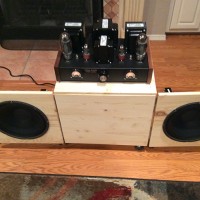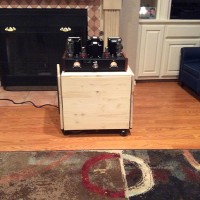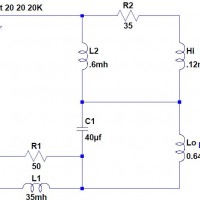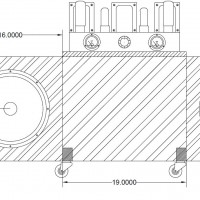
An Open Baffle Stereo Cart System
Designer:
Craig J Coley
Project Category:
Furniture
Project Level:
Beginner
Project Time:
1-8 Hours
Project Cost:
Under $100
Project Description:
This project is called the Coley OB12C Open Baffle Stereo Cart System. It is a full range coaxial open baffle speaker system with hinged and detachable baffles combined with a stereo stand and casters. It was specifically designed to be paired with the Coley 215SE Single Ended Triode Amplifier that is 15W/channel and uses no negative feedback.
Design Goals:
This project began as a desire to improve the portability of a tube amplifier and open baffle speaker set. It was decided to construct a rolling stereo cart with open baffle speakers mounted as hinged and detachable wings. This would allow the open baffles to either be folded out, detached and placed several feet away, or folded up into the cart for convenience. The overall folded dimensions are 19Wx16Dx18H, easily rolled and hidden in the corner of the living room when not in use.
Driver Selection:
It is best to use the largest woofer possible when constructing an open baffle speaker so an Eminence 12” coaxial woofer was chosen because it was the largest size possible with this enclosure. A Dayton polyimide tweeter was chosen because it could be crossed over at 1100 Hz, avoiding the 2 KHz hump in the Eminence response curve. The two drivers together, as a coaxial, save space and made the overall speaker size manageable.
Enclosure Design:
The center section of the cart is made from three (3) 19” long pieces of 16” wide edge glued pine forming the top, front and back. Four (4) pocket screws and glue are used to hold the front and rear covers to the top and an additional poplar 2×2 is installed on the center of the bottom edge from front to back as a stiffener. The caster wheels are mounted to four 2×2 poplar mounts glued and pocket screwed to the inside of the four corners.
The speaker baffles are 16×16, also made from edge glued pine. A 7” long laminated poplar 2×2 is pocket screwed and glued to the center bottom of each baffle to act as a rear support when the baffles are detached and free standing. The baffles are attached to the rear of the front cover with heavy duty lift-off hinges. If light duty hinges are used, expect a lot of sag when the wings are folded because the wings weigh almost 20 pounds each.
Edges of the panels were finished with a router and round-over bit. The 0.75 inch thickness of the speaker baffles allowed easy mounting of crossover components to the rear of the panel. Along the inside back cover are mounted an outlet strip and Bluetooth receiver, allowing both to remain hidden from view in normal operation but accessible if needed. Because solid wood is used, predrilling of holes is mandatory.
Enclosure Assembly:
Assembly is quite easy for anyone with minor woodworking skills. Pocket holes add strength and allow the screws to remain hidden.
Crossover Design:
Since I personally like the sound and smooth transfer characteristics, an 1100 Hertz two-way shunt crossover was used. Crossovers of this type interact with the electrical characteristics of the speaker drivers so once these parameters are measured, the entire circuit can be modeled in SPICE to optimize the component values and performance. In addition to the shunt crossover for the drivers, a series RL network was included to compensate the baffle losses that roll-off at 6dB per octave. The conjugate 6dB per octave reactance characteristics of the RL network will flatten the natural roll-off and thus flatten the frequency response of the entire system. A 10dB loss was deemed acceptable to have the necessary low frequency extension to make the Coley OB12C full range. Although the RL components are not available from Parts Express, they are easily available from other sources. The 35 and 50 ohm resistor used in the network is metal and highly recommend ed due to the higher heat dissipation capability.
Tips & Tricks:
This design counts on at least a 40 pound amplifier to counteract the imbalance of mounting and unmounting 20 pound hinged speakers. Also be careful rolling over thresholds between rooms because the combined 80 pounds of weight can cause the casters to hang; simply ease over thresholds and the cart will do fine.
Conclusion:
The portability and performance of this open baffle stereo cart is astounding. The transparent and encompassing bass of an open baffle makes for easy listening. At the end of an evening of listening, simply fold-up the speakers and roll the whole stereo into a corner of the room for convenience.
About the Designer:
This project was designed and constructed by Craig J. Coley of Burleson, TX. I work as an electrical designer and am listed as inventor on 8 US patents in the field of electro-optics. I have been an electronics hobbyist since I built my first Heath radio at age 7 and a ham radio operator since age 11. I can be contacted at craigjcoley@gmail.com.
Project Parts List:
|
Part # |
Description |
Qty |
|
290-504 |
Eminence Beta-12CX 12″ Coaxial Driver |
1 |
|
270-406 |
Dayton Audio DT250P-8 1″ Polyimide Compression Horn Driver 1-3/8″-18 TPI 8 Ohm |
1 |
|
027-442 |
Dayton Audio DMPC-40 40uF 250V Polypropylene Capacitor |
1 |
|
255-412 |
Jantzen Audio 0.60mH 15 AWG Air Core Inductor Crossover Coil |
1 |
|
N/A |
Triad C-56U 35.0mH Inductor |
1 |
|
N/A |
Vishay/Dale RH02550R00FC02, 50 Ohm, 25W Resistor |
1 |
|
N/A |
Vishay/Dale RH02535R00FC02, 35 Ohm, 25W Resistor |
1 |







+ There are no comments
Add yours